

Digital humanism #NET2018 @UoP_Nursing @AdvanceHE fantastic food for thought !!! Prof Steve Tee ty x… How to increase your impact with academic social media. The rise of social media is viewed by many as yet another means of procrastination.
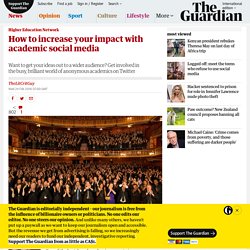
Yet academics are increasingly turning to Twitter, not just for entertainment and networking, but to engage audiences in a new way. One of the best-loved academic accounts is @NeinQuarterly; a feed that blends aphorisms, jokes and an expert knowledge of German literature and culture. It was established by Eric Jarosinski, a former US professor of German literature, writing under the nom de plume.
His work now appears in German and Dutch newspapers and has been turned into a book, Nein: A Manifesto, which was released last year. I had less grand ambitions when I started my own anonymous account, @TheLitCritGuy. I had to decide what to talk about, develop a posting schedule and realise the limits of my own knowledge – with a vocal group of followers I had to be honest about my own inexperience (I actually found it liberating to tell them when I didn’t know the answer to something).
Have a distinctive voice. The Facebook scandal won’t end the infuriating allure of academic social media. Social media: the good, the bad and the ugly. The A to Z of social media for academia. Why should academics be using social media?
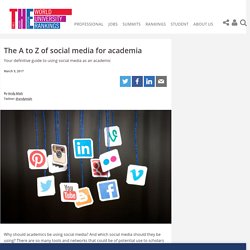
And which social media should they be using? There are so many tools and networks that could be of potential use to scholars that it can be difficult to keep track. Times Higher Education has teamed up with Andy Miah, chair in science communication and future media at the University of Salford, to offer you the definitive guide to the social media tools available to academics, and how you can use them as you go about your scholarly work. There are many, many tools, but we have tried to give an idea of how higher education professionals might use them.
Social media. Screencastomatic: How to record screencasts. Microsoft Sway: You may choose to use Sway to prepare your online collaborative presentation. Adobe Spark: You may choose to use Spark to prepare your online collaborative presentation. Videos about elements of digital fluency. DIGITAL SKILLS SECTOR REPORT NOV2016. Enhancing the digital experience for skills learners.
“Our vision is of a thriving economy made up of businesses able to compete internationally and respond to rapid technological change.
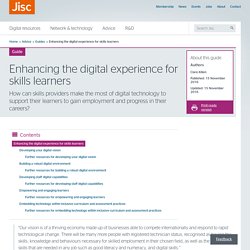
There will be many more people with registered technician status, recognised as having the skills, knowledge and behaviours necessary for skilled employment in their chosen field, as well as the transferable skills that are needed in any job such as good literacy and numeracy, and digital skills.”The post-16 skills plan (July 2016) published by the Department for Business Innovation and Skills and the Department for Education In July 2015 we commissioned research to explore the digital experiences of learners in the skills sector and to consult them on their needs and expectations. The study encompassed work-based learning (including apprenticeships), adult and community learning and offender learning. Read the full study findings published in November 2016 and our brief for leaders of apprenticeships, adult, community and offender learning. Key challenges. JR0079 ONLINE STUDY FINDINGS REPORT AUG2016 WEB ACCESSIBLE v3.
Students' experiences and expectations of the digital environment. 20 ways of thinking about digital literacy in higher education. Josie Fraser, social and educational technologist, Leicester City Council First define what you mean by digital literacy: The definition I most frequently use is this one: digital literacy = digital tool knowledge + critical thinking + social engagement.
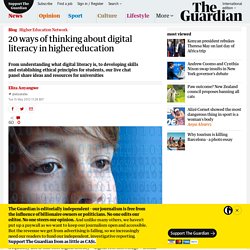
Then it's worth knowing its main characteristics: • It supports and helps develop traditional literacies• It's a life-long practice• It's about skills, competencies and critical reflection on how these skills and competencies are applied• It's about social engagement Top tips for developing the digital literacy of non-traditional students: Begin by exploring the ways in which the group are already using mobile and web based technologies. Many of them will already be engaging with tech for personal use, for example Skyping relatives, keeping in touch on Facebook or using mobile phones. The Difference Between Digital Literacy and Digital Fluency. Update 6/13/2012: We finally finished our book on this topic.
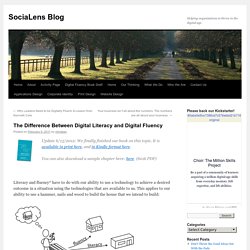
It is available in print here, and in Kindle format here. You can also download a sample chapter here: here (601k PDF) Home - Digital Fluency - Guides at Rasmussen College. UK HEA: Digital literacies. Digital fluency vs. digital literacy. How do we in higher education help students prepare for the future by becoming not only problem solvers but also problem creators?
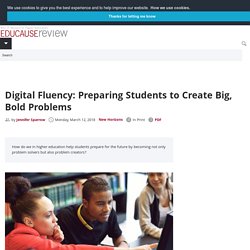
The 2017 report The Next Era of Human/Machine Partnerships states that 85 percent of the jobs that will be available in 2030 haven't even been invented yet.1 These types of predictive hypotheses often cause me to do a reality check. As I took time to reflect on the fact that 2030 is (incredibly) only 12 years away, I tried to think about the jobs that had not been invented 12 to 15 years ago. Did any child in 2003 say they wanted to be an offshore wind engineer, a drone operator, a data scientist, or a Lyft driver? These jobs are all new in the last 15 years. These careers exist because a person, or often a team of people, created big, bold problems for us to solve.